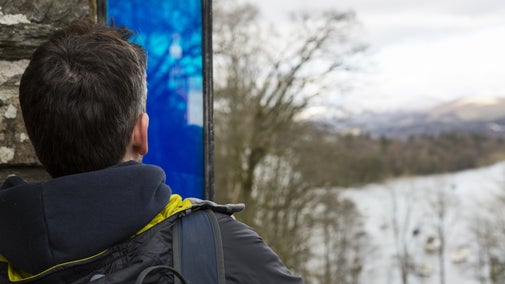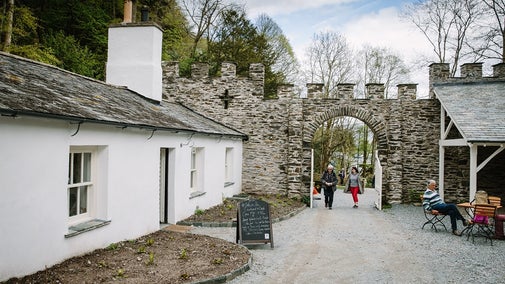
Donate
Everyone needs nature, now more than ever. Donate today and you could help people and nature to thrive at the places we care for.

It’s no small feat looking after the Claife Viewing Station and the land surrounding Lake Windermere; the area is a rich mosaic of farmland, woodland, upland tarns and mires and parkland. Our work at Windermere includes caring for the countryside, protecting pre-historic sites and helping hay meadows to thrive.
Visitors to Claife Viewing Station, Hill Top, Wray Castle and Hawkshead village today are enjoying what has been a hugely inspirational part of the countryside for hundreds of years. Beatrix Potter and William Wordsworth both took inspiration from the scenery here.
For the many thousands of people who come to enjoy the attractions of Bowness, the Claife woods on the west shore of Windermere form the backdrop to their visit.
Our job is to look after and improve the different aspects of the countryside and help you enjoy them. On some days that can mean planting parkland trees at Wray Castle, laying a hedge by Blelham Tarn or replacing a gate on a path.
On other days, it might be repairing damage from storms or other weather events. In November 2021, Storm Arwen caused extensive damage to the Windermere west shore footpath and repair work is still ongoing.
We’ve been working with the Lake District National Park to establish a series of new bridleways in the area to make walking and cycling safer and more enjoyable. The latest is between Hawkshead and Low Wray.

The Claife woods were once the ‘factory floor’ for charcoal production, coppicing and the tanneries, and they are rich in woodland archaeology. There are many charcoal pit-steads, pack horse bridges, potash kilns and even a bark barn.
We’ve recently spent time repairing and protecting these important sites, removing trees that are damaging the stonework and protecting them for the future.
On the Windermere lakeshore, reed beds are an important habitat for insects and nesting birds like coots, teal and golden eye. They were far more extensive in the past than they are today so we’re working with the South Cumbria Rivers Trust to re-establish pockets of reed beds in the sheltered bays along the west shore, to help improve their natural habitats.
We are currently felling a number of diseased larch trees to prevent the spread of Phytophthora ramorum, which is a fungus-like virus. It can attack and kill other trees, so it is necessary to take action and we are required by law to fell all larch trees within 100m of each infected tree.
Because of this, parts of the woodland above the Windermere shore will look quite different for a while. Phytophthora ramorum is not dangerous to humans, dogs or wildlife, but visitors can help to prevent the spread of the disease by staying on marked paths and cleaning mud and needles off boots, (and paws) and pram wheels before they leave.
There is no cure for Phytophthora ramorum and there are no effective chemical treatments available. There are fungicides which can suppress the symptoms, but none which kill the virus.
When phytophthora is confirmed the landowner (in this case, the National Trust) is issued with a Statutory Plant Health Notice (SPHN) by the Forestry Commission. This means that infected, spore producing trees, such as larch, must be felled or otherwise killed as quickly as possible after detection of the disease.
These areas will be replanted with a mixture of native trees and shrubs, things like Oak, Birch, Hazel, Cherry, Rowan, Hawthorn. Around 8,500 trees will be planted in tree tubes to protect from deer browsing. Scotts Pine, Norway Spruce and Douglas Fir will also be planted as landscape trees and to provide habitat and food for red squirrels.
Having a wide range of tree species in the planting mix means the woodland will be more robust to face the challenges of new tree pests and diseases and the uncertainty around climate change.
National Trust rangers work with local farmers to conserve hay meadows in the Lake District and create new ones where possible.
Now sitting within a World Heritage Site, hay meadows have been an integral part of the Lake District’s cultural landscape for hundreds of years, providing feed for livestock during the winter months.
With support from generous legacies, volunteers and the Cumbria Wildlife Trust, the National Trust has begun a two-year conservation project to restore the hay meadows in Grasmere, Borrowdale and Sizergh.
As well as their significance in farming, the vast mixture of wildflowers and grasses provides a huge food and nectar supply for bumblebees, birds and butterflies. The long grassland provides valuable cover for nesting birds like the endangered curlew and mammals such as brown hares.
The cyclical process of making hay – preparing the fields, moving livestock to allow grasses and flowers to grow and cutting and drying the hay grass – was a significant event in the farming calendar and within the local community.
By using the seed rich ‘green hay’, or in some cases ‘plug planting’ of hay meadow flowers to produce a new seed source, the we hope to kick start this restoration.

During the 20th century, an increase in demand for food led to the intensification of farming, and a greater use of fertiliser meant that while grass thrived, wildflowers did not. Because of this, bird species such as the corncrake, lapwing and curlew have declined dramatically.
In reducing the use of fertilisers and waiting until late summer to cut the meadows, there is more time for different flower and grass species to thrive and grow.
If you come across the ‘rangers in red’ when out and about in the South Lakes, do stop and say hello. They have lots of knowledge about countryside management, wildlife and the local area and are always happy to answer your questions and share their experience with you.
With your ongoing support, we're able to continue our vital conservation work. Thank you for helping to protect these special places.

Everyone needs nature, now more than ever. Donate today and you could help people and nature to thrive at the places we care for.
Claife Viewing Station offers endless lake views surrounded by lakeside strolls, longer bike rides and wildlife in the woodland. Leave the car behind and make the most of your trip.

Joey’s Café at Claife Viewing Station serves as a cosy pit-stop for those walking up to the station or setting out along the west shore. Will it be a slice of freshly baked cake or a frothy coffee?

Bring your dog to Claife Viewing Station and Windermere West Shore. With lakeside and woodland walks, it’s a great place for you and your four-legged friend to explore.

Discover how the viewing station was one of the first purpose-built monuments to entice early tourists to enjoy the views across Lake Windermere.

We believe that nature, beauty and history are for everyone. That’s why we’re supporting wildlife, protecting historic sites and more. Find out about our work.

Since the 1930s, over 97 per cent of the UK’s hay meadows have disappeared as a result of changes in farming practice. We are working with tenant farmers to restore pasture to hay meadow.

Read about our strategy, which focuses on restoring nature, ending unequal access and inspiring more people.
